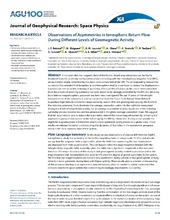| dc.contributor.author | Reistad, Jone Peter | |
| dc.contributor.author | Østgaard, Nikolai | |
| dc.contributor.author | Laundal, Karl Magnus | |
| dc.contributor.author | Ohma, Anders | |
| dc.contributor.author | Snekvik, Kristian | |
| dc.contributor.author | Tenfjord, Paul | |
| dc.contributor.author | Grocott, Adrian | |
| dc.contributor.author | Oksavik, Kjellmar | |
| dc.contributor.author | Milan, Steve | |
| dc.contributor.author | Haaland, Stein | |
| dc.date.accessioned | 2019-06-21T13:06:36Z | |
| dc.date.available | 2019-06-21T13:06:36Z | |
| dc.date.issued | 2018-06 | |
| dc.Published | Reistad JP, Østgaard N, Laundal KM, Ohma A, Snekvik K, Tenfjord PAR, Grocott A, Oksavik K, Milan S, Haaland SE. Observations of asymmetries in ionospheric return flow during different levels of geomagnetic activity. Journal of Geophysical Research - Space Physics. 2018;123(6):4638-4651 | eng |
| dc.identifier.issn | 2169-9402 | en_US |
| dc.identifier.issn | 2169-9380 | en_US |
| dc.identifier.uri | https://hdl.handle.net/1956/20344 | |
| dc.description.abstract | It is known that the magnetic field of the Earth's closed magnetosphere can be highly displaced from the quiet‐day configuration when interacting with the interplanetary magnetic field (IMF), an asymmetry largely controlled by the dawn‐dusk component of the IMF. The corresponding ionospheric convection has revealed that footprints in one hemisphere tend to move faster to reduce the displacement, a process we refer to as the restoring of symmetry. Although the influence on the return flow convection from the process of restoring symmetry has been shown to be strongly controlled by the IMF, the influence from internal magnetospheric processes has been less investigated. We use 14 years of line‐of‐sight measurements of the ionospheric plasma convection from the Super Dual Auroral Radar Network to produce high‐latitude convection maps sorted by season, IMF, and geomagnetic activity. We find that the restoring symmetry flows dominate the average convection pattern in the nightside ionosphere during low levels of magnetotail activity. For increasing magnetotail activity, signatures of the restoring symmetry process become less and less pronounced in the global average convection maps. We suggest that tail reconnection acts to reduce the asymmetric state of the closed magnetosphere by removing the asymmetric pressure distribution in the tail set up by the IMF By interaction. During active periods the nightside magnetosphere will therefore reach a more symmetric configuration on a global scale. These results are relevant for better understanding the dynamics of flux tubes in the asymmetric geospace, which is the most common state of the system. | en_US |
| dc.language.iso | eng | eng |
| dc.publisher | Wiley | en_US |
| dc.relation.uri | https://agupubs.onlinelibrary.wiley.com/doi/10.1029/2017JA025051 | |
| dc.rights | Attribution CC BY | eng |
| dc.rights.uri | http://creativecommons.org/licenses/by/4.0 | eng |
| dc.title | Observations of asymmetries in ionospheric return flow during different levels of geomagnetic activity | en_US |
| dc.type | Peer reviewed | |
| dc.type | Journal article | |
| dc.date.updated | 2019-01-24T12:18:11Z | |
| dc.description.version | publishedVersion | en_US |
| dc.rights.holder | Copyright 2018 The Author(s) | en_US |
| dc.identifier.doi | https://doi.org/10.1029/2017ja025051 | |
| dc.identifier.cristin | 1586715 | |
| dc.source.journal | Journal of Geophysical Research - Space Physics | |
| dc.relation.project | Fulbright: - | |
| dc.relation.project | Andre: NERC NE/P001556/1 | |
| dc.relation.project | Norges forskningsråd: 223252 | |
| dc.relation.project | Andre: STFC ST/M001059/1 | |

